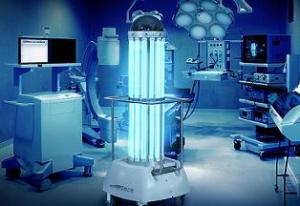Dec 16 2010
A team of researchers including William A. Rutala, Maria F. Gergen, and David J. Weber at the University of North Carolina Health Care, have published outcomes of their investigation titled, ‘Room Decontamination with UV Radiation’, in the recent issue of Infection Control and Hospital Epidemiology magazine.
Their eight-month investigation focused on analyzing the capability of Total Room Ultraviolet Disinfection (Tru-D), an automated UV device in removing MRSA, Clostridium difficile, a MDR strain of Acinetobacter baumannii and VRE contamination from the rooms of patients. The investigation recognizes problems linked with manual decontamination methods and offers considerable opportunities to offer better contaminant-free environment to the patients.
 Tru-D UV Device
Tru-D UV Device
During the initial phase of testing, various samples of Acinetobacter baumannii, MRSA, VRE and Clostridium difficile were positioned at the back of the objects and within Tru-D’s line-of-sight. It was determined that around 99.9% of vegetative bacteria were reduced by the device within a span of 15 minutes. Within 50 minutes Clostridium difficile spores were reduced by more than 99.8%.
For the second phase, samples were taken from the seclusion rooms for patients who were infected by MRSA or VRE. After exposing the samples to UV-C for fifteen minutes, significant reduction in net CFUs (384 vs. 19) were found in MRSA counts per plate (37 vs. 2) and MRSA counts per plate (37 vs. 2). Similar outcomes were reported for VRE. Further, considerable reduction of 3.3-3.9 log10 were recorded when contaminants were hidden from direct exposure to UV-C.
The study concluded that Tru-D is an eco-friendly device and is competent in considerable reduction of disease causing agents found on both the shadowed and line-of sight surfaces of the environment. The outcomes of Tru-D investigation are not valid for alike, second-tier UV-C devices. Tru-D is listed in ETL and is UL STD 61010-1 compliant.